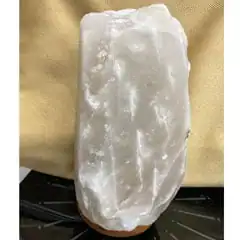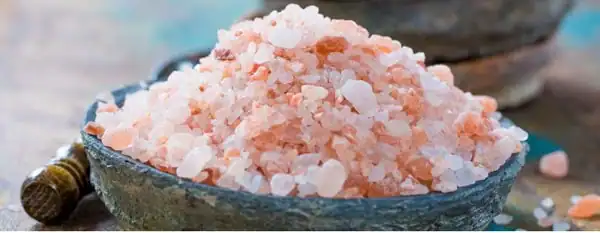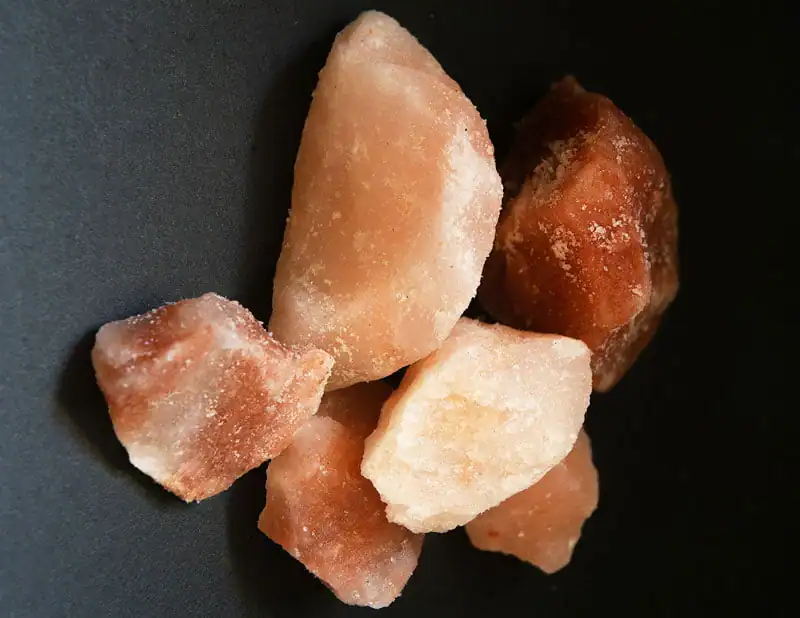Himalayan salt is a unique and versatile ingredient that is widely used in cooking and wellness practices. One of the most striking features is the color of Himalayan salt with its unique pink color. However, Himalayan salt can also come in other colors such as red, orange, white, and even black.
From the traditional pink Himalayan salt to the lesser-known red, orange, white, and black Himalayan salt, I will explore how the color variation is caused, and how it may or may not affect the taste.
What Colors Can Himalayan Salt Be (Is it Always Pink?)
Himalayan salt is so well known for its unique pink color, that it has color palettes named after it!
The characteristic pink color is caused by the presence of iron oxide. When more iron oxide is present, the color tend to be deeper, to the point it can look red or orange. Himalayan salt also contains a wide range of trace minerals, but they do not affect the color as much as the iron oxide does. To learn more about all the trace minerals available when consuming Himalayan salt, be sure to see our article Minerals In Himalayan Salt: Let’s See What’s in There.
The color of Himalayan salt can vary depending on the location where it is mined and the specific mineral content of the salt. The salt that is mined from the upper levels of the mine tends to be a brighter pink color, while the salt from deeper layers is often a stronger red to orange color.
The black salt is also known as “Kala Namak” is a manufactured salt product, so technically is more a seasoning than a salt. Perhaps there is some naturally occurring Himalayan Black salt somewhere (or there was at one time), which gets its color from sulfur, but to fill the demand for it, an alternative was created. The products you’ll find available on the market are made by combining Himalayan salt (the pink stuff) with charcoal, tree bark, various seeds & berries, soda ash, sodium carbonate and bicarbonate, and sodium sulfate. Then the whole mixture is placed inside pottery jars with lids and is heated in a kiln until it melts.

Here is a bit more about the different colors you can find:
Pink Himalayan Salt
Native to the ancient Khewra Salt Mine in Pakistan’s Punjab province, Pink Himalayan salt is recognized as one of Earth’s purest salts. Its unique pink hue originates from its abundance of minerals like zinc, iron oxide, calcium and magnesium…these trace elements also contribute to potential health benefits when added into your diet.
White Himalayan Salt
A white Himalayan salt is a prized type of rock salt that hails from the Khewra Salt Mine, just like its pink counterpart. Even though it still contains essential minerals such as sodium, chloride, calcium, magnesium and zinc in abundance, what sets it apart is its lower iron content which eliminates any hint of rosy coloration unlike the latter. So if you’re looking for unique flavor with an unmatched mineral-richness then white Himalayan salt should definitely be your choice!

Since white ground salt in a dish could be most any kind of salt, I thought you’d rather see a picture of a rare White Himalayan Salt lamp to demonstrate that even Himalayan Salt can be white when it lacks iron oxide.
Red and Orange Himalayan Salt
Extracted from the Khewra Salt Mine in Pakistan, red and orange Himalayan salt is richer in iron oxide than pink Himalayan salt, resulting in its darker hue. But that’s not all! Red and orange varieties are also significantly higher in minerals, making them even healthier to enjoy compared to their paler counterpart.
Black Himalayan Salt
Robust Black Himalayan Salt, also known as “Kala Namak” has a potent sulfur content that contributes to its distinctive color and flavor. Some people associate the strong sulfur smell with “rotten eggs”. It is the same smell that you find around sulfur laden water in places with naturally occurring hot springs, such as Hot Sulfur Springs, CO or Glenwood Springs, CO near the Yampah Vapor Caves.
Black Himalayan salt is typically used for spicing up dishes like curries or chutneys. When first trying this salt, use a whole lot less than you normally would with any other salt. It is very pungent and can quickly overwhelm your food! Personally, I like more subtle salts and this one is too strongly flavored for me (and I’m not fond of the smell either).

Does The Color Of Himalayan Salt Affect Its Taste?
In general, the taste of white, pink, red or orange Himalayan salt is similar to that of other types of salt no matter the color.
Himalayan salt has a slightly milder, smoother and more complex taste than table salt. I find it to be closer to the flavor profile of naturally evaporated sea salt, than to common table salt which is often produced via vacuum extraction from underground salt mines. For more about that process, see our article What Is Salt?
It is important to note that the color of Himalayan salt can vary slightly depending on where it is mined and the overall mineral content of the specific location.
Black Himalayan salt is a seasoning that is manufactured and has a flavor that is quite different from the others – see above for a description of how it is produced.
Final Thoughts
Himalayan salt is a unique and versatile ingredient that can be used for culinary purposes. The color of the salt varies depending on where it is mined, but pink salt is the most common. Other colors such as white, orange or red are also available with different minerals in them but the flavor profiles are fairly similar. Whether you’re using it to season food or just as an aesthetic addition to your dish, Himalayan salts are sure to bring something special to any meal!
Featured Photo by stephan hinni







